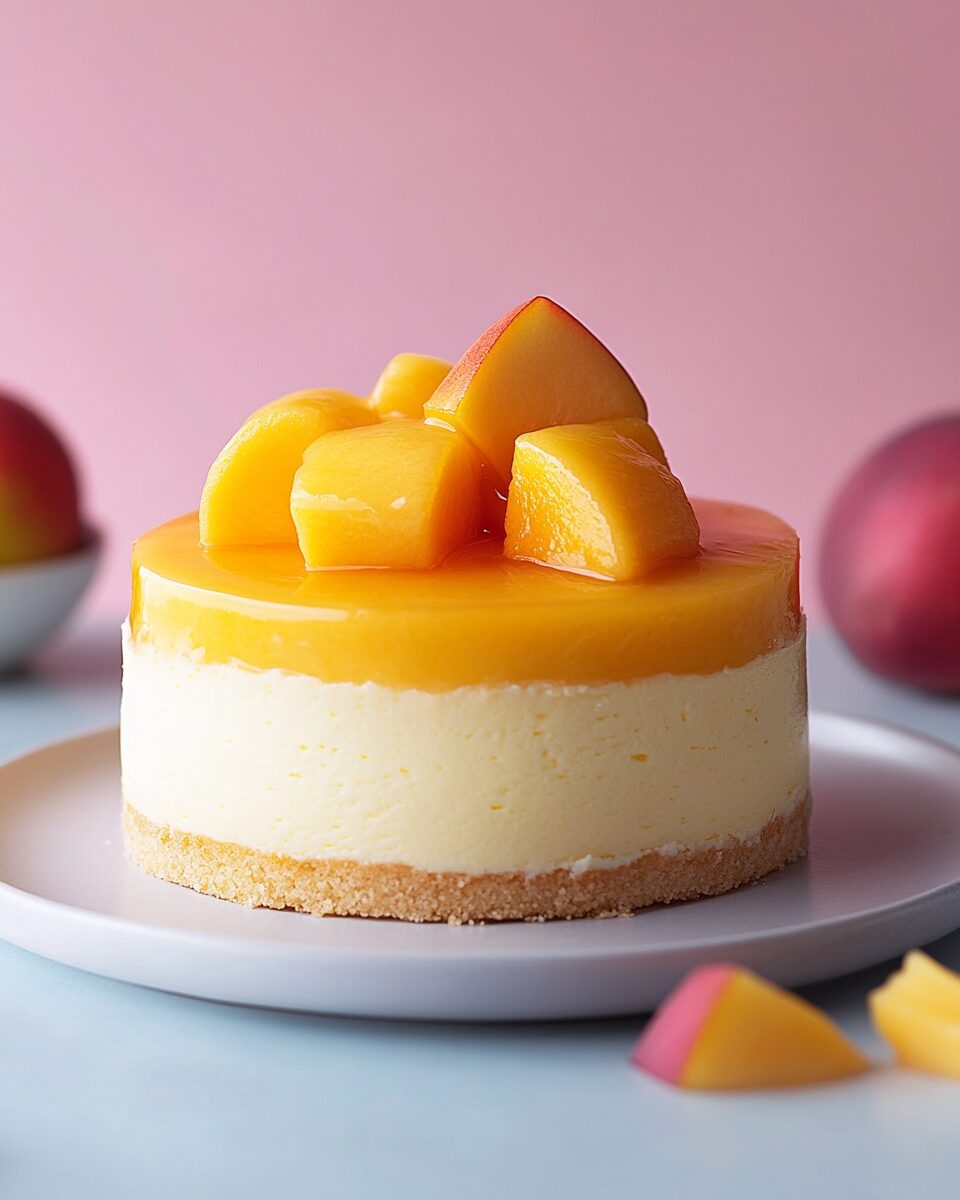The Mango Japanese Cheesecake is a dreamy fusion of airy elegance and tropical sunshine. Unlike dense American-style cheesecakes, this version floats like a cloud on your tongue, thanks to whipped egg whites folded into a mango kissed batter. The subtle tartness of ripe mango mingles with cream cheese for a balanced, creamy delight that’s both comforting and refreshing.
Perfectly chilled and elegantly simple, this cake makes a stellar centerpiece for a spring brunch or a light summer dessert. It’s a recipe that balances indulgence with sophistication ideal for those seeking a lighter, fruit-forward twist on a classic favorite. Serve it with passion fruit drizzle or fresh mango slices for extra flair, or enjoy its silky texture all on its own.
Full Recipe:
Ingredients:
-
200g cream cheese, softened
-
60g unsalted butter
-
100ml whole milk
-
6 large eggs, separated
-
100g granulated sugar
-
1 teaspoon vanilla extract
-
70g cake flour
-
30g cornstarch
-
1/4 teaspoon salt
-
2 ripe mangoes, pureed
Directions:
-
Preheat your oven to 320°F (160°C). Line the base and sides of an 8-inch (20 cm) round cake pan with parchment paper.
-
Puree the ripe mangoes until smooth and set aside.
-
In a double boiler, melt the cream cheese, butter, and milk until smooth and creamy. Let cool slightly.
-
Whisk the egg yolks and sugar until pale and fluffy. Add the vanilla extract, followed by the cream cheese mixture and mango puree. Mix until fully combined.
-
Sift in cake flour, cornstarch, and salt. Gently fold the dry ingredients into the mango mixture.
-
In a separate clean bowl, whip the egg whites until stiff peaks form. Carefully fold them into the batter in thirds, being gentle to preserve the airy texture.
-
Pour the batter into the prepared pan. Tap lightly to release air bubbles.
-
Bake in a water bath for 60–70 minutes or until the top is golden and the center is set.
-
Let the cake cool in the oven with the door slightly ajar. Refrigerate for a few hours or overnight before serving.
Prep Time: 25 minutes | Cooking Time: 70 minutes | Total Time: 1 hour 35 minutes
Kcal: ~210 kcal per slice | Servings: 8 servings
The Ethereal Delight of Mango Japanese Cheesecake: A Tropical Fusion of Elegance and Flavor
When it comes to indulgent desserts, cheesecake holds a special place across cultures and cuisines. But few versions of this iconic treat inspire the kind of reverent silence and delighted surprise that the Japanese cheesecake does. Add to this the vibrant tropical allure of ripe mangoes, and you get a dessert that’s not only visually captivating but also a true celebration of texture, flavor, and cultural harmony.
The Mango Japanese Cheesecake is more than just a cake it’s a culinary experience that dances delicately between East and West, simplicity and sophistication. While traditional Western style cheesecakes are rich, dense, and often intensely sweet, the Japanese version is a marvel of lightness, combining the creaminess of a custard with the lift of a sponge cake. The addition of mango elevates it to a new level, infusing every bite with fruity brightness and a refreshing tang that lingers pleasantly on the palate.
A Brief History: The Origins of Japanese Cheesecake
Japanese cheesecake, also known as soufflé cheesecake or cotton cheesecake, finds its roots in the 1960s when Japanese chefs began adapting Western baking techniques to suit local palates. They sought a version of cheesecake that felt less heavy, more delicate, and more aligned with the Japanese culinary philosophy of subtlety and balance.
The result was a cake that incorporated whipped egg whites, much like a soufflé, and often omitted the heavy crust commonly found in Western counterparts. Unlike its American cousin, which leans heavily on cream cheese and often includes sour cream for richness, Japanese cheesecake is more modest in fat content and flourishes thanks to its airiness.
As Japan continued to embrace and innovate Western desserts, countless variations emerged. One of the most beloved among them is the mango-infused variation, which brings a delightful contrast of creamy texture and fruity vibrance.
Why Mango? The Perfect Tropical Companion
Mangoes bring more than just exotic charm to the table they add complexity. Their natural sweetness is balanced by a slight acidity, creating a dynamic flavor profile that complements the mild tang of cream cheese. In this cheesecake, ripe mango puree is folded into the batter, infusing the entire cake with golden sunshine.
The fruit also contributes moisture, giving the cake an even silkier mouthfeel. Because Japanese cheesecake is so subtle and light, the mango never overpowers instead, it coaxes out the creamy notes of the cheese and brightens the entire experience.
For many, mango isn’t just a flavor; it’s a nostalgic connection to summer days, tropical vacations, or heritage. Incorporating it into such a classic, refined dessert allows it to shine in an entirely new light.
A Textural Masterpiece
One of the hallmarks of a Japanese cheesecake is its unique texture. It’s simultaneously creamy and fluffy, dense yet light, with a gentle wobble when cooled. The secret lies in the careful folding of meringue into the rich cream cheese mixture. When done correctly, this process creates a structure that’s airy yet stable, soft yet sliceable.
With mango added into the mix, the texture gains an added creaminess from the fruit’s moisture content. The result is something akin to biting into a mango-laced cloud softer than a sponge cake, but lighter than a mousse. The cake almost melts in your mouth, making it difficult to stop at just one slice.
This balance of texture is what has earned Japanese cheesecake its cult following. It’s elegant enough for a celebration, but comforting enough for an afternoon treat.
Cultural Intersection: Where East Meets West
The Mango Japanese Cheesecake is emblematic of modern fusion cuisine. It’s born from the Western influence of cheesecake, reimagined with Japanese culinary techniques, and infused with tropical Southeast Asian flavors. It represents more than just a dessert; it’s a story of global gastronomy, where borders blur and ingredients from different corners of the world come together in harmony.
In many ways, it also symbolizes the changing palate of the 21st-century baker someone who respects tradition but is eager to explore, combine, and innovate. It’s the perfect dessert for anyone who enjoys the creativity of cross-cultural culinary experimentation.
Tips for the Perfect Cake
While we’re not delving into the specifics of how to make the cake here, it’s worth discussing some important considerations that make this cheesecake sing:
-
Ripe Mangoes Are Key: The sweetness and flavor of the mango largely determine the success of this cake. Choose mangoes that are fully ripe but not overripe to avoid bitterness or excess moisture.
-
Gentle Folding Is Essential: The meringue must be carefully incorporated to maintain the cake’s signature texture. Overmixing can deflate the batter, while undermixing can create streaks.
-
Water Bath Baking: Japanese cheesecakes benefit immensely from baking in a water bath. It prevents the cake from cracking and ensures a smooth, custard-like consistency.
-
Cooling Gradually: Letting the cake cool in the oven with the door slightly ajar helps prevent the dramatic sinking that can occur with such delicate textures.
Variations and Creative Twists
One of the best things about this cake is how versatile it is. Here are some ways to make it your own:
-
Add a Swirl: Try swirling in passion fruit puree or raspberry coulis for added visual and flavor complexity.
-
Top It Off: A mango glaze or thin slices of fresh mango arranged in a rosette can add a decorative flourish.
-
Coconut Fusion: Fold in toasted coconut flakes for a tropical crunch and added depth.
-
Mango-Lime Zest: Grating a little lime zest into the batter adds brightness and enhances the fruit’s complexity.
-
Mini Cheesecakes: Bake in ramekins or muffin tins for individual servings perfect for parties or gifting.
Healthier Indulgence
Compared to traditional cheesecakes, the Japanese version is often perceived as lighter and less guilt-inducing. It uses less sugar and fat, and the whipped egg whites help create volume without relying on heavy cream. The addition of mango not only enhances flavor but also adds vitamin C, antioxidants, and natural sweetness.
Of course, it’s still dessert but it’s one you can feel good about enjoying in moderation. It also aligns well with more modern dietary preferences that seek balance and pleasure without excess.
Serving Suggestions
Presentation matters when it comes to such a beautiful cake. Here are a few elegant ways to serve your Mango Japanese Cheesecake:
-
Chilled with Mango Slices: Keep it simple and let the flavor shine. Serve each slice with fresh mango on the side.
-
With Whipped Cream and Mint: Add a dollop of whipped cream and a mint sprig for color contrast and a fresh finish.
-
Paired with Tea: Japanese green tea or a floral oolong complements the lightness of the cake beautifully.
-
Dessert Platter: Serve as part of a tropical dessert board with coconut macaroons, passion fruit mousse, and lychee sorbet.
Conclusion:
The Mango Japanese Cheesecake is more than just a dessert it’s a tribute to culinary elegance and innovation. It marries the structure and technique of traditional Japanese baking with the bright, joyful flavor of mango, resulting in a cake that’s as stunning on the plate as it is delightful to eat.
Whether you’re a seasoned baker looking for your next masterpiece or someone seeking a lighter alternative to classic cheesecake, this dessert offers a little slice of sunshine with every bite. It’s soft yet structured, sweet yet refined, and endlessly customizable.
In a world where desserts often lean into decadence and indulgence, the Mango Japanese Cheesecake is a breath of fresh air subtle, stunning, and deeply satisfying. One forkful, and you’ll understand why this tropical twist on a beloved classic continues to capture the hearts (and tastebuds) of dessert lovers around the globe.

